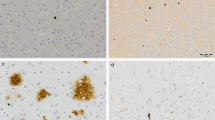Abstract
SMALL, discrete masses of argyrophilic particles, with a mean diameter of 50–60µ, were first seen in the cerebral cortex by Blocq and Marinesco1 and named “senile plaques” by Simchowicz2, who discovered large numbers of these lesions in cases of senile dementia. Since they may be present in the normal old person3 and no close relationship between intensity of plaque formation and clinical changes was found by some workers4, their relevance for senile dementia—the extreme form of intellectual decay of old age—has often been called into question. More recently Corsellis5 has demonstrated a reasonably good correlation between clinical diagnosis and neuropathological changes in post-mortem studies of aged mental hospital patients. But the nature and extent of the relationship between plaque formation and mental deterioration in old age remained uncertain. An attempt has been made to shed further light on this problem by enquiries in a series of patients, aged 60 years and more, admitted with psychiatric or physical illness to mental and geriatric hospitals and subsequently studied at post-mortem. The aim was to carry out a quantitative assessment of the severity of dementia in individual subjects during life and to ascertain whether this bore any relationship with mean plaque counts in cerebral grey matter. At this stage of the enquiry cases with gross cerebrovascular lesions were excluded as there was no available technique for making a quantitative estimate of their extent. The degree of dementia was expressed in quantitative form by carrying out the two following assessments.
This is a preview of subscription content, access via your institution
Access options
Subscribe to this journal
Receive 51 print issues and online access
$199.00 per year
only $3.90 per issue
Buy this article
- Purchase on Springer Link
- Instant access to full article PDF
Prices may be subject to local taxes which are calculated during checkout
Similar content being viewed by others
References
Blocq, P., and Marinesco, G., Sem. Méd. Paris, 12, 445 (1982).
Simchowicz, T., Hist. Histopath. Arb., 4, 267 (1910).
Gellerstedt, N., Uppsala Läk Fören. Förh., 38, 193 (1933).
Rothschild, D., Amer. J. Psychiat., 93, 757 (1937); 98, 324 (1941).
Corsellis, J. A. N., Mental Illness and the Ageing Brain (Oxford Univ. Press, London, 1962).
Roth, M., and Hopkins, B. A., J. Ment. Sci., 99, 451 (1953).
Shapiro, M. B., Post, F., et al., J. Ment. Sci., 102, 233 (1956).
Kay, D. W. K., Acta Psychiat. Scand., 38, 249 (1962).
Author information
Authors and Affiliations
Rights and permissions
About this article
Cite this article
ROTH, M., TOMLINSON, B. & BLESSED, G. Correlation between Scores for Dementia and Counts of ‘Senile Plaques’ in Cerebral Grey Matter of Elderly Subjects. Nature 209, 109–110 (1966). https://doi.org/10.1038/209109a0
Issue Date:
DOI: https://doi.org/10.1038/209109a0
This article is cited by
-
Questions concerning the role of amyloid-β in the definition, aetiology and diagnosis of Alzheimer’s disease
Acta Neuropathologica (2018)
-
Biomarkers in Amyloid-β Immunotherapy Trials in Alzheimer’s Disease
Neuropsychopharmacology (2014)
-
Hippocampal sclerosis of aging, a prevalent and high-morbidity brain disease
Acta Neuropathologica (2013)
Comments
By submitting a comment you agree to abide by our Terms and Community Guidelines. If you find something abusive or that does not comply with our terms or guidelines please flag it as inappropriate.



